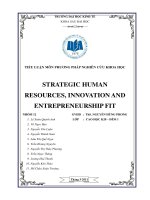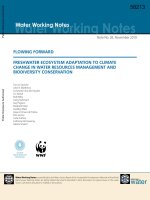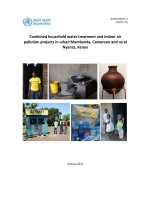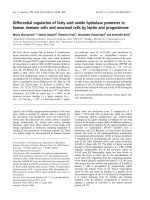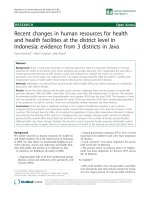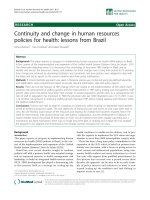Projects in human resources training and developement
Bạn đang xem bản rút gọn của tài liệu. Xem và tải ngay bản đầy đủ của tài liệu tại đây (2.31 MB, 225 trang )
MANAGING
PROJECTS
IN HUMAN
RESOURCES,
TRAINING AND
DEVELOPMENT
Vivien Martin
Vivien Martin
MANAGING PROJECTS
IN HUMAN
RESOURCES, TRAINING
AND DEVELOPMENT
London and Philadelphia
Publisher’s note
Every possible effort has been made to ensure that the information contained in this
book is accurate at the time of going to press, and the publishers and authors cannot
accept responsibility for any errors or omissions, however caused. No responsibility
for loss or damage occasioned to any person acting, or refraining from action, as a
result of the material in this publication can be accepted by the editor, the publisher
or any of the authors.
First published in Great Britain and the United States in 2006 by Kogan Page Limited
Apart from any fair dealing for the purposes of research or private study, or criticism
or review, as permitted under the Copyright, Designs and Patents Act 1988, this
publication may only be reproduced, stored or transmitted, in any form or by any
means, with the prior permission in writing of the publishers, or in the case of
reprographic reproduction in accordance with the terms and licences issued by the
CLA. Enquiries concerning reproduction outside these terms should be sent to the
publishers at the undermentioned addresses:
525 South 4th Street, 241
Philadelphia PA 19147
USA
© Vivien Martin, 2006
The right of Vivien Martin to be identified as the author of this work has been asserted
by her in accordance with the Copyright, Designs and Patents Act 1988.
ISBN 0 7494 4479 7
British Library Cataloguing-in-Publication Data
A CIP record for this book is available from the British Library.
Library of Congress Cataloging-in-Publication Data
Martin, Vivien, 1947-
Managing projects in human resources, training and development /
Vivien
Martin.
p. cm.
Includes bibliographical references and index.
ISBN 0-7494-4479-7
1. Project management. 2. Personnel management. I. Title.
HD69.P75.M365 2006
658.3’12404—dc22
2005020322
Typeset by Digital Publishing Solutions
Printed and bound in the United States by Thomson-Shore, Inc
120 Pentonville Road
London N1 9JN
United Kingdom
www.kogan-page.co.uk
Contents
Introduction 1
1. What is a project? 7
Projects and change 7
Features of a project 8
Aims 10
Setting clear objectives 11
Key dimensions of a project 12
People in projects 14
Projects in HR, training and development 15
Outcomes and multiple outcomes 16
Achieving outcomes 17
2. Scoping the project 19
Why scope a project? 20
The life of a project 21
3. Questions, evidence and decisions 29
Does this project meet a need? 29
Figures and tables vii
Acknowledgements viii
Does it help to achieve organizational goals? 32
Have we considered all the options? 32
Option appraisal 34
Cost-effectiveness 35
Opportunities and threats 35
Is this project feasible? 36
Should we do a pilot study? 39
Is the benefit worth the cost? 41
4. Defining the project 45
Working with the sponsor 45
Will the project be supported? 47
Stakeholder mapping 49
Working with your stakeholders 52
Creating the project brief 54
Structure of the project brief 56
5. Managing risk 59
Risk and contingency planning 59
Preparing to manage risks 61
Risk assessment and impact analysis 63
Strategies for dealing with risk 64
A contingency plan 65
A framework for managing risk 66
Influencing stakeholders 67
6. Outline planning 71
Where do you start? 72
Developing a project plan 74
Using a logic diagram 75
Identifying deliverables 79
7. Estimating time and costs 85
Estimating time 85
Work breakdown structure 86
Staff costs 90
Avoiding abusive practices 91
Equipment costs 93
Materials costs 94
Estimating revenues and intangible benefits 95
Who should estimate? 95
Planning for quality 96
iv
Contents
8. Scheduling 97
Timing and sequence 97
Drawing up a Gantt chart 98
Using computer programs to plan and schedule 99
Identifying the critical path 100
9. Implementing the project 107
Drawing up the implementation plan 107
Team structure 108
Planning team responsibilities 110
Making it happen 111
Resourcing 112
Managing project activities during implementation 112
Keeping an overview 114
10. Monitoring and control 117
Monitoring 118
Milestones 121
Maintaining balance 122
Controlling change 124
11. Communications 125
Communications in a project 125
Why is good communication needed? 127
How can communication be provided? 128
Managing the flow of information 129
Providing information for those who need it 130
Where is information needed? 135
Access to information and confidentiality 136
What might hinder communication? 137
12. Leadership and teamworking 139
The nature of leadership 139
Leadership in a project 140
Power in leadership of projects 141
Style in leadership of projects 143
Leadership roles in a project 144
Motivation and teamworking 146
Team development 147
Managing yourself 150
13. Managing people and performance 151
Preparing for good performance 151
Contents
v
Managing performance of teams in a project 153
Managing relationships and conflict 154
Making requirements explicit 157
Ensuring that the team have the necessary skills and experience 157
Developing collaboration 159
Dealing with poor performance 160
14. Completing the project 163
Handover and delivery 164
Delivering with style 166
Planning for a successful conclusion 166
Closing the project 167
Closure checklists 168
Dismantling the team 169
Project drift 170
15. Evaluating the project 173
Evaluation during a project 174
Evaluation at the end of a project 175
Designing a formal evaluation 176
Planning an evaluation 177
Analysing and reporting the results 181
Follow-up to the report 182
16. Reporting the project 183
Writing a project report 183
Characteristics of a good report 185
Style, structure and format 186
Reporting the project to gain an academic or professional award 188
Making effective presentations 190
Understanding your audience 191
Who is in your audience? 192
Purpose and content 193
Delivery 195
17. Learning from the project 199
Organizational learning about management of projects 199
Sharing learning from a project 202
Individual development from a project 204
Management development through leading a project 205
vi
Contents
References 209
Index 211
Figures and tables
FIGURES
2.1 A project life cycle 21
6.1 Logic diagram for directory production 77
8.1 A Gantt chart to design a new assessment centre 99
8.2 Critical path for relocation of an office 103
10.1 A simple project control loop 119
TABLES
5.1 Risk probability and impact 64
5.2 Format for a risk register 66
5.3 Stakeholder analysis, stage 1 67
5.4 Stakeholder analysis, stage 2 68
7.1 Work breakdown structure for implementation of a new
appraisal system 89
8.1 Part of the work breakdown structure for relocation of
101
8.2 Time estimates for relocation of an office 102
an office
Acknowledgements
I would like to acknowledge the contribution made to this book by
colleagues in the Open University Business School who helped to shape
my ideas and writing in the field of project management. Some of the
material in this book was published in a similar form but in a different
context as Managing Projects in Health and Social Care, published by
Routledge in 2002. Acknowledgement is also due to Eddie Fisher, Stephen
Oliver and others who have contributed ideas from their experience.
Introduction
This book will provide you with a practical approach to managing a project
in an HR, training or development setting. People are often expected to man-
age projects as part of their day-to-day work but few receive special training
to help them to take on this task. If you are one of these people, help is at
hand!
This book will help you to manage your first project and will be a useful
handbook for use in any future projects you find yourself invited to manage.
It focuses on projects that might be carried out by staff at an operational level
but will also be attractive to more senior people who are managing projects
for the first time. Each chapter discusses an aspect of project management
and includes examples drawn from HR, training and development settings.
Techniques are introduced and applied to examples, and there are ‘pauses
for thought’ to encourage you to think ideas through. Further references are
provided for those who want to learn more about project management.
Successful management of a project is quite a balancing act and can only
be learnt through reflection on experience, supported by thoughtful consid-
eration of the ideas, processes and techniques that have become recognized
as the expertise of project management. The opportunity to take responsibil-
ity for a project offers personal and career development as well as the
opportunity to contribute to achieving a worthwhile change.
HOW TO USE THIS BOOK
The chapters are arranged roughly in the order of things that you need to
consider when managing a project. Unfortunately, however, projects do not
often progress neatly through one logical stage after another. If you are man-
aging a project for the first time you might find it useful to glance through
the overview of chapters and note the issues that are raised so that you can
plan how to make best use of the book to support your own learning needs.
Projects come in many different shapes and sizes, and some of the tech-
niques and processes described here will seem unnecessary for small projects.
In some cases, the processes can be reduced or carried out more informally
when a project is not too large or complicated, but beware of missing out
essential basic thinking. The chapter on scoping a project, and that about
developing the evidence base, focus on making sure that the project has a
clear and appropriate aim and enough support to achieve its purpose. Many
projects founder because they are set up quickly to address issues that people
feel are very urgent, and the urge to take action means that the ideas are not
fully considered. Rushing the initial thinking can result in failure to achieve
objectives and even more delay.
Planning is not a one-off activity but more like a continuous cycle of plan,
do, review and plan again. With a small team and in a setting where
people are comfortable with flexible working, the sharing and sequencing of
tasks might be agreed quickly. If you are managing a project that does not
need some of the techniques that are offered in these chapters, then don’t use
them – there is no one ‘right’ way to manage or lead a project. Each project
is different, and you need to develop the knowledge and flexibility to be able
to match your management approach to each individual project. It helps to
have a broad general knowledge about a variety of approaches so that you
can be selective and make an appropriate choice.
You might like to think of the book as support for your personal approach
when you take responsibility for a project. Consult the book to give you con-
fidence that you have thought through the main issues. Use it to prepare for
important meetings. Check the relevant chapters as you move through the
stages of the project. Take the opportunities for learning and self-develop-
ment offered by participation in a project, and keep the book on your shelf
for the next time. Successful project managers are always in demand.
Many people following courses leading to qualifications will have to
complete a work-based project as part of their study. This is an oppor-
tunity to make a contribution to your work area as well as to progress your
own development. This book is written to support the practical roles
of a person leading or managing a project in the workplace, but the
2
Managing projects in human resources
models, techniques, processes and concepts introduced are those considered
in professional and management courses of study.
OVERVIEW OF CHAPTERS
Chapter 1 What is a project?
Some of the features that are common to any project are identified and their
importance discussed. There is an emphasis on clarifying the purpose of the
project and setting clear aims and objectives. The chapter concludes with a
consideration of the outcomes that are to be achieved.
Chapter 2 Scoping the project
This considers what is included in the project and where the boundaries lie.
One of the most commonly used models of project management is introduced
and used to help to clarify the choices to be made.
Chapter 3 Questions, evidence and decisions
It is often tempting to move straight into planning a project once an idea has
been enthusiastically received. This chapter encourages you to check, from a
number of different perspectives, whether there is any evidence that the
project is likely to succeed. The focus is on questioning whether the project
is worth doing and whether it will be able to achieve what it is intended to
do. Option appraisal is discussed and the potential benefits of carrying out a
pilot study are considered.
Chapter 4 Defining the project
The focus here is on developing a detailed project brief that will be signed off
by the person responsible for funding the project and supported by all the
key stakeholders in the project.
Chapter 5 Managing risk
This offers an approach to management of risk and contingency planning.
Risk is inevitable in a project and it would be impossible to achieve anything
without exposing ourselves to some degree of risk. The chapter covers risk
Introduction
3
assessment and impact analysis and suggests some strategies for dealing
with risk.
Chapter 6 Outline planning
Where do you start? Some straightforward approaches to developing a
project plan are explained to help you to identify exactly what the project
must produce.
Chapter 7 Estimating time and costs
Once the outline plans have been developed, estimates will be needed for the
costs of the activities that contribute to the project and for the time that each
activity will take. More information is needed to make these estimates, and
this chapter introduces a structured approach to planning the work of a
project so that these estimates can be made with some confidence.
Chapter 8 Scheduling
This covers the timing and sequence of activities in the project. The sequence
is very important when one task must be completed before another begins.
The time that each task will take needs to be estimated before the length
of the project can be confirmed, and this overall time will depend on the
extent to which tasks and activities have to be delayed until others are
completed. Some basic techniques are introduced that will help you to make
these calculations.
Chapter 9 Implementing the project
This is the exciting stage in a project when the plans begin to be enacted. The
focus moves to managing action and ensuring that the project team or teams
can start work and understand what is needed. The project manager needs
also to consider how to secure personal support when it is needed and how
to retain an overview whilst responding to the inevitable detail of the day-
to-day tasks.
Chapter 10 Monitoring and control
It is essential to monitor if you are to be able to control progress on the project.
The monitoring information can be reviewed against the plan to show
whether everything is proceeding according to the plan. If not, the project
4
Managing projects in human resources
manager can bring the project back into control by taking action to recover
the balance of time, cost and quality.
Chapter 11 Communications
This focuses on the need for effective communications in a project and the
things that a project manager can do to provide appropriate systems. Much
of the communication in a project is in connection with sharing information.
Management of the flow of information is considered alongside a reminder
of the responsibility of the project manager in ensuring that confidentialities
are respected.
Chapter 12 Leadership and teamworking
After some comment on the nature of leadership, this chapter focuses on
leadership issues in a project. Leadership and teamworking are closely linked
and motivation is also considered.
Chapter 13 Managing people and performance
One of the things that a project manager can do in the early stages of a project
is to prepare for good performance. It is much easier to manage performance
to ensure that the project is successful if the performance requirements have
been made specific and the staff have been adequately prepared. If the worst
happens and a manager has to deal with poor performance, it is essential to
have policies and procedures in place to ensure that the actions taken are
legal and fair to the individuals concerned.
Chapter 14 Completing the project
The implementation of a project ends with completion, but there are often a
number of outcomes with elements that have to be handed over to the project
sponsor. There are choices about how these things are delivered. There are
also a number of steps to take in ensuring that a project is closed properly so
that any remaining resources are accounted for and all of the contractual
relationships have been concluded.
Chapter 15 Evaluating the project
Most projects end with an evaluation and it often falls to the project manager
to design and plan the process. This chapter outlines the process and ends
with some consideration of the issues that may arise in presenting a report.
Introduction
5
Chapter 16 Reporting the project
This chapter deals with two areas that often worry project managers, how to
develop a full written report and how to make an oral presentation. Different
types of reports are appropriate for different types of audience, so there are
a number of different types of decision to be made when preparing either a
written or oral report.
Chapter 17 Learning from the project
Most projects will have aspects that go well and others that do not go so well.
There is always a lot that can be learnt but much of the learning will be lost
if care is not taken to ensure that it is captured. There is also considerable
potential for personal learning and for management development during a
project.
6
Managing projects in human resources
1
What is a project?
Many people find themselves working on projects from time to time, and you
may find yourself invited to lead or manage a project. Sometimes people are
asked to join a project team as part of their workload, and sometimes they
are seconded to work exclusively on a project for a defined period of time.
Some people are appointed to fixed-term jobs that are entirely concerned with
work on one specific project.
So what is a project? We use the word ‘project’ to describe something that
is not part of ordinary day-to-day work. It also indicates something that is
purposeful and distinct in character. In this chapter we consider how to dis-
tinguish a project from other work and some of the particular characteristics
of projects in HR, training and development settings. We also outline some
of the factors that contribute to successful completion of projects.
PROJECTS AND CHANGE
Projects at work can be of many different types. Some may be short term, for
example, organizing a special event, making a major purchase or moving an
office. Or they may be bigger, longer and involve more people – for example,
a project that involves developing a new service or a new function or moving
a service area to a new location. The project may be expected to deliver an
improvement to services, for example programmes and courses, or products,
for example training materials or CD ROMs. It may be expected to deliver
financial benefits to the organization in some way. In the public sector,
projects are normally expected to lead to social, economic and political
outcomes.
Projects contribute to the management of change. However, change man-
agement usually refers to substantial organizational change that might
include many different types of change in many different areas of work, while
project management usually refers to one specific aspect of the change. There-
fore, projects are often distinct elements in wider organizational change.
Example 1.1
A project as part of change management
A large hospital was merging with a smaller community healthcare
organization that offered a range of services in local surgeries, and
through home visits to patients. The development of the new merged
organization was a long and complex process, but there were a num-
ber of projects identified that contributed to achieving change. These
included:
࿖
development of new personnel policies;
࿖
relocation of directorate offices;
࿖
disposal of surplus estates;
࿖
development and implementation of financial systems for the new
organization;
࿖
development and implementation of new management informa-
tion system.
Many other changes were less well defined: for example, teambuild-
ing among the new teams of directors, managers, clinical and profes-
sional leaders and functional teams. These could not be managed as
projects but became part of a wider change management approach.
FEATURES OF A PROJECT
We normally use the term ‘project’ in quite a precise way although it can
encompass many different types of activity. It can refer to a short personal
project, for example, planning and holding a special celebration. It can also
8
Managing projects in human resources
refer to a major construction, for example, a project to build a new school. All
projects are different but they do have certain features in common. A project:
࿖
has a clear purpose that can be achieved in a limited time;
࿖
has a clear end when the outcome has been achieved;
࿖
is resourced to achieve specific outcomes;
࿖
has someone acting as a sponsor or commissioner who expects the out-
comes to be delivered on time;
࿖
is a one-off activity and will not normally be repeated.
As in any activity within an organization, there are constraints which limit
the process in various ways. For example, policies and procedures may con-
strain the ways in which things are done. The outcomes that are required may
be defined very precisely, and measures may be put in place to ensure that
the outcomes conform to the specified requirements. Once a project has been
defined it is possible to estimate the resources that will be needed to achieve
the desired outcomes within the desired time. A project is usually expected
to achieve outcomes that will only be required once, and so projects are not
normally repeated. Even if a pilot project is set up to try out an idea, the
outcome from the pilot should achieve what was required without the need
to conduct another pilot project (unless different ideas are subsequently to
be explored). Working on a project is not like ongoing everyday work pro-
cesses unless all your work is focused through project working.
PAUSE FOR THOUGHT
Which of the following activities would you consider to be projects?
Yes No
(a) Developing a new, documented induction
procedure
❏❏
(b) Establishing a jointly agreed protocol to
review the quality provided by a new
cleaning service
❏❏
(c) Maintaining client records for a home
delivery service
❏❏
(d) Managing staff rotas ❏❏
(e) Transferring client records from a card file
to a new computer system
❏❏
What is a project?
9
Yes No
(f) Setting up a management information
system
❏❏
We would say that (a), (b) and (e) fall within our definition of a
project, whereas (c) and (d) are routine activities and are therefore not
projects. In the case of (f) it is important to distinguish between the
development of a management information system (which might
benefit from a project management approach) and the subsequent
process of ensuring that appropriate data is entered into the system
and used for management, which is part of normal routine activity.
Managing or leading a project is different from taking such a role in everyday
work simply because of the limited nature of a project. There is a limit to the
length of time that anyone in the project team will be in that role. There is a
limit to the type of work an individual is expected to contribute to the project.
Some members of a project team may be selected to bring appropriate exper-
tise and others will be selected for other reasons. For example, an experienced
administrator whose everyday work is with staff induction and performance
processes might be asked to lead the project team not because of his or her
expertise in administration but because that person has demonstrated lead-
ership in his or her area of work.
AIMS
It is often said that aims describe the ultimate goal, the purpose of the project,
while objectives describe the steps that are necessary to achieve that goal. If
you ask, ‘What is the purpose of the project?’ this will help to identify the
overall aims. The aims can also be described as the vision. In some ways, using
the word ‘vision’ is helpful as it implies having a picture of success. Aims can
encompass values alongside purpose, which is helpful as it can describe the
outcome in terms of how it should be achieved. It can also identify any
important aspects of the outcome that relate to the values of the organization.
Aims can express a vision and describe a purpose, but clear objectives provide
the details that describe how the aim will be achieved.
10
Managing projects in human resources
SETTING CLEAR OBJECTIVES
It is very important to set clear objectives because these describe exactly what
you are aiming to achieve and will provide the only way to know whether
you have succeeded or not. It is often easy to agree the broad goals of the
project, but these need to be translated into objectives if they are to be used
to plan the project and to guide the assessment of whether it has achieved
what was intended.
Objectives are clear when they define what is to be achieved, say when that
is to be completed and explain how everyone will know that the objective has
been achieved. Many people use the word SMART to remind themselves of
the areas to consider when setting clear objectives:
࿖
Specific – clearly defined with completion criteria.
࿖
Measurable – you will know when they have been achieved.
࿖
Achievable – within the current environment and with the skills that are
available.
࿖
Realistic – not trying to achieve the impossible.
࿖
Timebound – limited by a completion date.
If you write objectives that include all these aspects, you will have described
what has to be done to achieve the objectives. This makes objectives a very
useful tool in a planning process. However, as planning often has to be revis-
ited as events unfold, you will also find that you have to revisit objec-
tives, and maybe revise them as you progress through the project. This is
when aims can be very helpful in reminding everyone of the intentions and
purpose.
Example 1.2
A clear objective
An objective for an HR project might be stated as:
To inform staff about the new procedure for reporting and
recording sick leave.
This objective meets some of the criteria of a SMART objective but not
others. It is reasonably specific, stating that the purpose is to inform
staff about the new procedure. However, it does not give any infor-
mation about how this will be done or when, or how success might
What is a project?
11
be measured. The quality, timescale and costs are not mentioned here.
How shall we know when the objective has been completed success-
fully? What quality issues are there? We might know when the
information has been given to staff, but we won’t know how success-
ful the project has been unless we know more about whether it was
achieved within the budget and whether it was finished on time. A
more SMART objective could be written as:
To produce 500 attractive and easy to read leaflets setting out
the new procedure for reporting and recording sick leave within
the budget of £250 and ensure that it is distributed to all staff by
30 September.
It is now clear that success can be measured by quality of leaflets,
produced within budget and distributed within the timescale. For the
project to succeed, a further objective would be necessary to ensure
that staff use the new procedures.
There will usually be a number of objectives to complete in order to achieve
the goals of a project. These objectives can be grouped into clusters that lead
to completion of different parts of the project. Objectives are important in two
ways in a project: they identify exactly what has to be done, and they allow
you to establish whether or not each objective has been achieved.
The objectives that you set in the early stages of the project provide a
framework for the final evaluation. They also provide information that will
help you to monitor the progress of the project so that it can be controlled
and managed.
KEY DIMENSIONS OF A PROJECT
There are three key dimensions to a project:
࿖
budget;
࿖
time;
࿖
quality.
These have to be balanced to manage a project successfully. A successfully
completed project would finish on time, within the estimated budget and
12
Managing projects in human resources
having achieved all of the quality requirements. These three dimensions of
budget, time and quality are often regarded as the aspects of a project that
must be kept in an appropriate balance if the project is to achieve a successful
outcome. The job of the person leading or managing the project is to keep a
balance that enables all of these dimensions to be managed effectively.
These dimensions are in tension with each other, and any action taken that
is focused on one of the dimensions will impact on both of the others. For
example, if a reduction is made in the budget, there might be an impact on
the timescale if fewer people are available to carry out the activities, or there
might be an impact on the quality of the outcomes if the activities are rushed.
These dimensions are useful to keep in mind throughout the progress of a
project because actions and decisions will often impact on one or another of
these dimensions and upset the balance. If the balance is upset, the danger is
that the project will fail to keep within the agreed budget, fail to complete by
the target date or fail to produce outcomes of the quality required.
Example 1.3
An unbalanced project
A project was set up within a training centre to improve the training
programme on data protection and confidentiality, which staff had
found boring and not relevant to their own work. A budget and
timescale were agreed and a small team was formed to carry out the
project. The work started but soon ran into problems because the
government announced that the law on data protection was to be en-
hanced and strengthened. The project manager gained agreement to
increase the timescale to allow for this additional work. However, this
delay caused quality problems, because the current programme
needed to be improved urgently and it was soon acknowledged that
the improvement could not wait until details of the new legislation
were announced. The project manager revised the plans to enable the
team to carry out immediate improvements to the programme but to
do this within a much shorter timescale and a reduced budget. It was
agreed that more substantial changes would be made by setting up a
new project when the new legislation was completed.
The manager of this project had to switch his attention frequently
from budget to time and then to quality, considering the impact on
each of these dimensions as the project progressed.
What is a project?
13
PEOPLE IN PROJECTS
Although this model of three dimensions helps us to keep an overview of
projects, another crucial dimension to keep in mind is the involvement of
people in projects. People are central to every aspect of a project. People
commission and sponsor projects, agree to provide resources, support or
challenge projects, and contribute their energy and intelligence to carry out
projects. People take roles in delivering projects as leaders, managers and
team members, and others influence projects as sponsors, stakeholders, men-
tors, coaches and expert advisors. With so many people involved, projects
are strongly influenced by how these people feel and talk about the project
and how people behave in relation to the project.
Example 1.4
A project sensitive to people
A consultancy service was commissioned by a large organization to
provide a development programme for senior managers. Many staff
thought that participation would influence promotion decisions, so
the project was very sensitive in terms of how people would be se-
lected to be participants in the programme. Other roles also needed
to be considered, including who would present elements of the pro-
gramme and who would support participants as line managers or
mentors. As the ultimate purpose of the project was to improve the
organization’s products and services, some involvement from cus-
tomers was important. There was also interest from the press and
from several professional bodies and trade unions.
In this project the extensive range of interests was managed by de-
signing each aspect of the project with involvement of people with
particular interests and concerns. A competence framework for senior
managers aspiring to directorships was developed through consulta-
tion with all the organization’s directors. Senior managers and pro-
fessionals were also interviewed to develop a competence framework
that would enable development of ‘middle’ level staff into more senior
positions. Senior staff and directors were trained to make selection
decisions using these frameworks. The involvement of staff at several
levels in developing criteria and in the selection processes ensured
that the development programme was widely understood and its
methods accepted within the organization.
14
Managing projects in human resources
When a project is particularly sensitive to ‘people’ issues it may be possible
to consider the implications of different ways of balancing the key dimen-
sions of time, budget and quality. It may be possible to deliver the intended
outcomes in different ways, perhaps by using more or less involvement of
people and their time.
PROJECTS IN HR, TRAINING AND
DEVELOPMENT
Inevitably, any project that takes place in a setting concerned with training
and developing people or managing the performance and welfare of people
at work will reflect the particular concerns and values of the human resources
(HR) perspective. This is not, of course, a single viewpoint. HR departments
are strongly aligned with the missions, values and cultures of their workplace
and therefore vary as much as organizations vary. Many organizations, par-
ticularly those without large numbers of staff, do not have an HR department
but manage their staff within their general management structures. Again,
the approaches to training, development and management of people will
vary.
There is some common ground in the management of people in work-
places. There is legislation governing basic rights of employees, although the
details of such legislation varies from country to country and may change
frequently. Common ground also exists in the recognition that it is people
who carry out the work of the organization, however mechanized it may be,
and that people need to be rewarded for their work and to be motivated to
want to work. There is also similarity in the expectations that employers have
of employees, particularly the expectation that employees will produce the
outcomes that the employer is paying them to achieve – although in some
sectors and organizations, these expectations seem to change frequently.
Project management is a relatively recent approach to management. It is a
particularly effective approach to gaining management control, and enables
a focus on use of resources to gain specific objectives. It does, however,
require different organizational structures:
The rapid rate of change in both technology and the marketplace has
created enormous strains on existing organizational forms. The tradi-
tional structure is highly bureaucratic, and experience has shown that
it cannot respond rapidly enough to a changing environment. Thus the
traditional structure must be replaced by project management, or other
What is a project?
15
temporary management structures that are highly organic and can
respond very rapidly as situations develop inside and outside the
company.
(Kerzner, 2003: 2)
HR management approaches have also developed in the context of large,
relatively stable bureaucratic and hierarchical organizational structures. If a
significant amount of an organization’s work is managed through project
structures there are implications for how staff are recruited, inducted, devel-
oped and managed. Projects are usually short-term, focused, un-hierarchical
and operate under considerable time pressure. This makes it difficult to use
the traditional approaches to bring recruits into the workplace and to develop
and manage their performance.
OUTCOMES AND MULTIPLE OUTCOMES
A project is usually intended to achieve at least one distinct outcome. For
example, a project to develop and test an induction manual should do exactly
that. The project brief should identify all of the outputs that will be required
to ensure that the project is ‘signed off’ as successful.
It is possible, however, to build in other outcomes that add value to the
activity. One obvious opportunity is to use the project to enable personal
development for those carrying out the various tasks. Alongside staff devel-
opment there might be an opportunity for a team to work together to develop
their teamworking approach, although project teams are usually temporary
and assembled only to complete the project. Projects are often used as part of
individual staff development to give experience of planning, managing and
leading a team. If you are able to demonstrate that you have successful expe-
rience in managing a project it can contribute to your promotion prospects.
Also, projects are often used as vehicles for learning when people are study-
ing for qualifications.
Projects offer rich opportunities for staff development. These include
opportunities to plan and manage the project, to liaise with people at different
levels within the organization and to carry out and report on the progress of
numerous tasks. Any project can be viewed as a set of specific tasks and
activities, each of which demands skills and experience to perform well
but also offers the opportunity for someone to gain the necessary skills and
experience if suitable training or coaching is provided. This last point is cru-
cial, and carries implications for all aspects of the project. If the project is to
be used as a training ground the necessary support must be built into the
16
Managing projects in human resources

